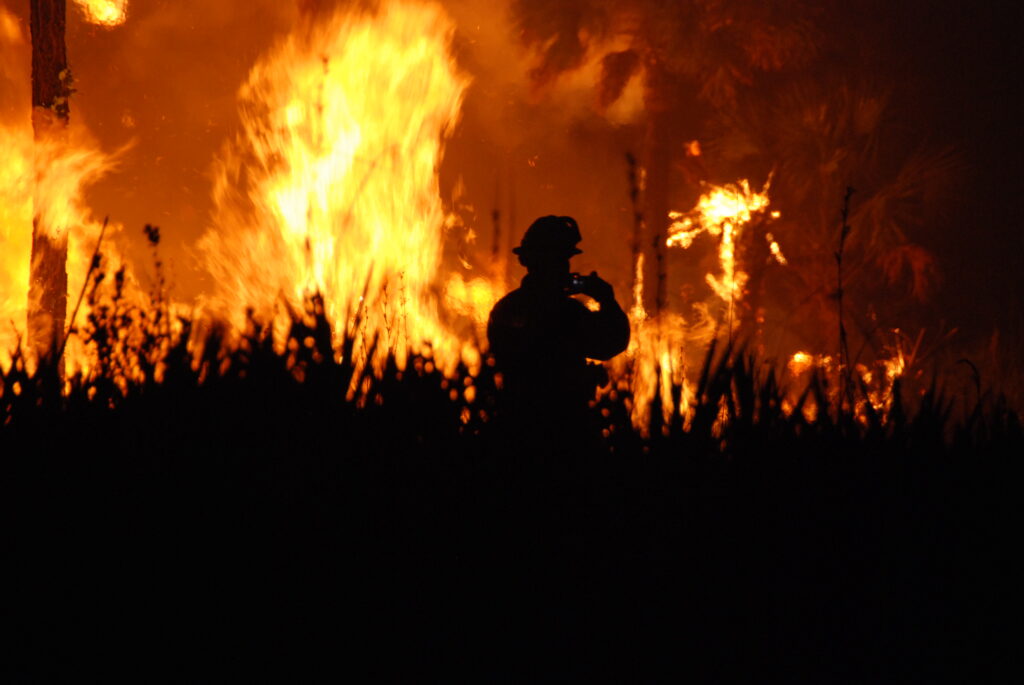By Kirsten Romaguera Rabin, UF/IFAS Communications
In a new analysis of data spanning more than three decades in the eastern United States published Monday, a team of scientists found a concerning trend — an increasing number of wildfires across a large swath of America.
“It’s a serious issue that people aren’t paying enough attention to: We have a rising incidence of wildfires across several regions of the U.S., not only in the West,” said Victoria Donovan, lead author of the study and an assistant professor of forest management at the UF/IFAS West Florida Research and Education Center. “We’re allocating the majority of resources to fire suppression in the western part of the country, but we have evidence that other areas are going to need resources, too.”
The team used data from the federal Monitoring Trends in Burn Severity Database from the years 1984 to 2020, the most recently available dataset at the time, to quantify the characteristics of large wildfires — each burning over 200 hectares, or 490 acres. This included identifying which regions during that period had the largest fires, most land burned and seasonality factors.
Their findings indicated increasing wildfire risk across the southern and eastern portions of what’s known as the Eastern Temperate Forests, an area that roughly bisects the country from Michigan in the north to the eastern half of Texas in the south.
“The eastern U.S. has the most expansive wildland-urban interface in the country and thus is at high risk from wildfire,” Donovan said. “The thought behind this research was that if there are signals that wildfires are increasing, we need to understand what those changes look like.”

Particularly in the Southeast, Donovan said, the data showed increasing trends in wildfire numbers, the size of the events, total hectares burned, shifts in seasonality and overall increases in the annual probability of large wildfires.
“We didn’t see the same trends in the northern part of the region we examined, but that doesn’t mean there were no wildfires there,” she said. “This data only included large wildfires, so smaller fires may have been occurring in that time.”
Three major factors influence wildfire regimes, which is the term fire scientists use to refer to an overall pattern in which fires naturally occur in a given ecosystem.
“The first is the ignition pattern, or what starts the fires,” Donovan said. “The second is changes in vegetation or fuel patterns, and then you have climate characteristics. We don’t address the drivers of the trends in this study, but it’s hard to talk about changing conditions without considering that climate may be a factor.”
As far as ignition patterns are concerned, Donovan said human ignitions still make up the majority of wildfires; but this is unsurprising in these areas, especially, being home to the majority of the country’s population. This category also accounts for human-created infrastructure, like power lines.
“It’s not necessarily human ignitions driving the trend of increasing wildfire patterns,” she said. “In other words, we’re not seeing an indication that there are proportionally more human-caused ignitions than there have been in the past. In the Southern Coastal Plain, which includes much of Florida, lightning ignitions played an important role, too, contributing more to the total area burned in the ecoregion despite being a less frequent cause of large wildfire ignition.”
Overall, Donovan says the study highlights the need for proactive management of forested land and individual preparedness for people living in the eastern United States.
“We don’t have the expansive wildfire problem that the western U.S. does yet, so this is also an opportunity to get ahead of the problem and prepare for shifting wildfire patterns before we start seeing the frequent destructive fires that we’re seeing in the West,” Donovan said. “We’re hopeful that this study will spur more research into understanding changing wildfire patterns in the east, but also that it will help to support an increase in prescribed fire management and motivate people to better prepare for wildfire in their location by hardening their homes and making escape plans.”
The study, “Increasing Large Wildfire in the Eastern United States,” was funded by the U.S. Department of Agriculture’s National Institute of Food and Agriculture and the Gulf Research Program of the National Academies of Sciences, Engineering, and Medicine. It is published in the journal Geophysical Research Letters: doi.org/10.1029/2023GL107051.
This piece was originally published at https://blogs.ifas.ufl.edu/news/2023/12/18/wildfires-increasing-across-eastern-u-s-new-study-reveals/.
Sign up for The Invading Sea newsletter by visiting here. If you are interested in submitting an opinion piece to The Invading Sea, email Editor Nathan Crabbe at ncrabbe@fau.edu.



